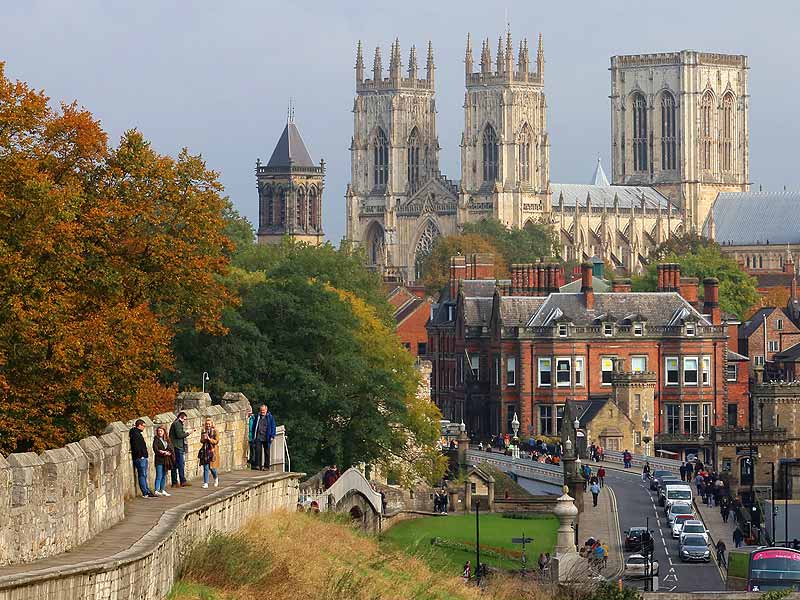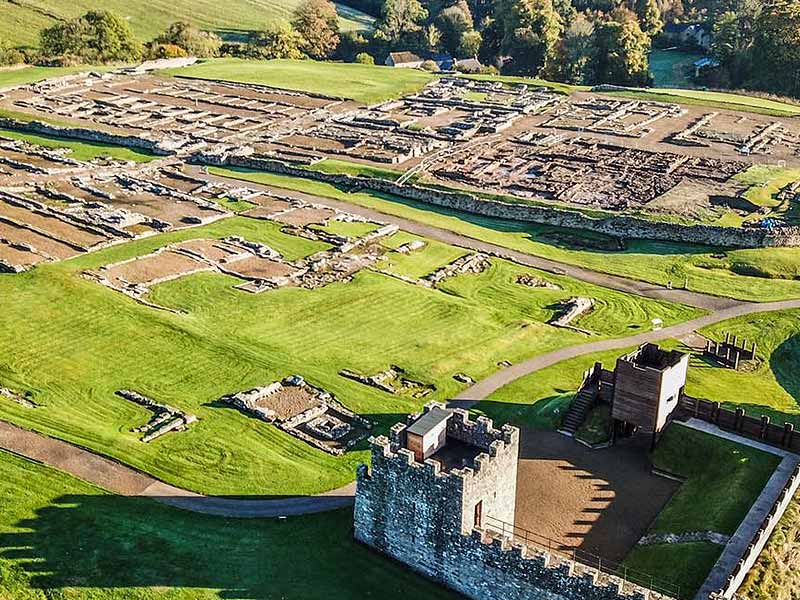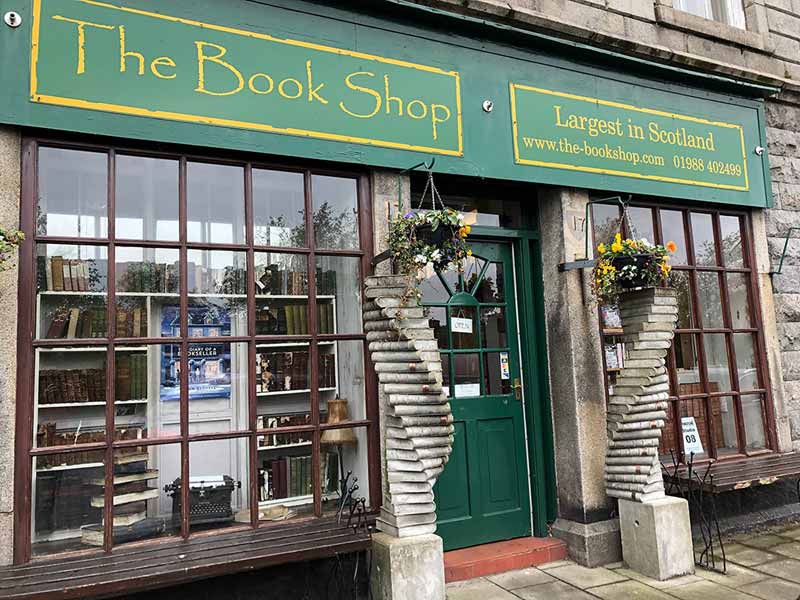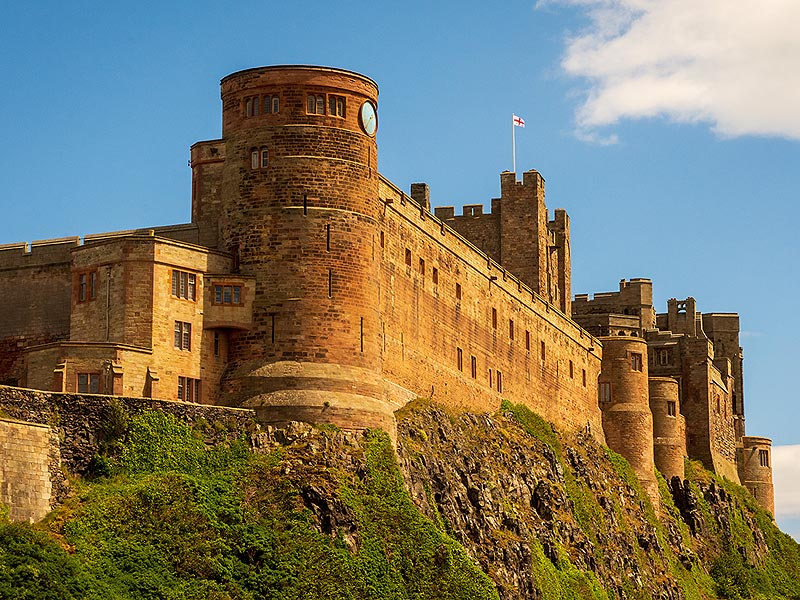
The tour is sold out, but the waitlist is open!
We’ll notify you via phone and email if any openings arise and you have 24 hours to respond before we move to the next person on the waitlist. Cancel your waitlist registration at any time for any reason and receive a full refund.
Tour Highlights | Pricing | Speakers | Accommodations | FAQs
Event Summary
![]() here was once a land so wild and savage its inhabitants and landscape were said to swallow entire Roman legions, terrify kings and assimilate the most fearsome invaders of their times—the Vikings.
here was once a land so wild and savage its inhabitants and landscape were said to swallow entire Roman legions, terrify kings and assimilate the most fearsome invaders of their times—the Vikings.
In more recent times this area has served as the ever satisfying playground of archaeologists and the inspiration for some of English literature’s greatest prose. But echoing through its vast grandeur remains the traces of its greatest conqueror—the Gospel of Jesus Christ. Where terror and might once reigned supreme, the inexorable influence of Christianity transformed a fiercely pagan region into a valiant and independent culture, one where preserving a pre-Protestant tradition became a source of identity. The Scottish characteristic of opposing tyrants was merged with the thriving infrastructure of the Anglo-Saxons and together they created a glorious ambition for the Gospel that spread throughout the rest of Christendom.
We are speaking of the old Kingdom of Northumbria, also known as “The Borders”, an area bracketed by the Solway Firth and the Rivers Tyne and Tweed. This area defined the corridor of conquest and stretched from York to Edinburgh, comprised of those legendary border towns such as Carlisle, Berwick, Newcastle, Selkirk and Dumfries. It includes places of great renown such as Nottingham and Sherwood Forest, Cumbria and the Lake District, the old stomping-grounds of Beatrix Potter and Sir Walter Scott, Poets John Keats and William Wordsworth.
The mountains and dales of this forbidding land have changed little over the centuries despite becoming the area that funneled invasion forces into the north or south for hundreds of years. The Celts, Anglo-Saxons, Romans, Vikings and the French/Normans all came by sea, but never content to remain in the coastal areas, they successively claimed the neck of Great Britain throughout the generations. They formed clans who answered only to themselves and a Borderers’ code of honor. Rife with raiding rebels they often created a lawless no—mans-land on both sides of the disputed boundary.
In old Northumbria we will encounter world changers such as Edward I and Henry VIII, William Wallace and Harry Hotspur Percy, St. Aidan and King Oswald. Trekking from the Middle Ages to the Reformation all the way to the Industrial Revolution, across the landscapes of history—islands and castles, manors and walled cities, moors and glens, where once you had but imagination from stories—you will leave with a Gospel-enriched affection for history and reformation.

York, England

York Minster

Battle of Marston, 1644

Cumbria Lake District

Brougham Castle

Carlisle

Hadrian’s Wall

Roman and Borders Museum

Nottingham

Sherwood Forest

Wigtown

Abbotsford House
What to Expect
We believe in freedom, so this is not your typical “follow the flag” tour. You’re making a substantial investment in this tour and the last thing we want to do is hold you captive to a group for 10 days, so we have built in a lot of liberty for each guest. We will do most of the guiding on the coach as we travel so when we arrive at a venue you will get a brief site-specific history, an option for a “house tour” followed by free time to explore areas of personal interest and perhaps do some shopping. Want to skip a venue? Feel free, we will let you know how to reunite with the group when you are ready. You wont miss a word with our wireless headsets that allow you to peruse the area while we tell you all about it.
Think of it as a informational and experiential buffet. We will do our best to offer loads of content, including evening walks and after dinner discussions, and you choose your favorites, as little or as much as you like.
When it comes to most provided meals, we will designate restaurant for lunch or dinner and let you go in when you want, with who you want, and order what you want. You take care of any alcohol, we take care of the rest. Freedom, it’s a good thing.
![]()
he England/Scotland Borders Tour features unique historic sites related to vital aspects of the history of the United Kingdom. York is the most important City in the north of England, and always has been. We will walk the ancient walls that still define the circumference of the old town, with stops at museums, the Cathedral (York Minster), the Viking Center, and some of the quaint shops still plying their wares along the way. A short drive will bring us to the Castle of Nottingham and Sherwood Forest, both located in the heart of the Robin Hood lore celebrated in stories, books, and film.
This tour is replete with castles and battlefields (often one and the same) since the history here is filled with conflict and imperial pretensions. We will visit Marston Moor, a defining engagement of the English Civil Wars, and Flodden, which dramatically changed the history of Scotland. Brougham Castle, one of the Clifford family estates and a target of Scottish armies, Caerleverock Castle, a magnificent triangular and moated stronghold of the Maxwell family of the Scottish borders and scene of siege and battle, along with historic Alnwick and Bamburgh Castles and their exciting stories are integral to our touring agenda.
The beautiful home of Sir Walter Scot, Abbotsford, is one of the most unforgettable sites in Scotland, as are the Abbeys at Melrose and Lindisfarne. We will conclude our tours with visits to the greatest castle of them all in Edinburgh and the great High Kirk of St. Giles, whose pastor was God’s great apostle of Scotland, John Knox.
![]() (July 8-10)
(July 8-10)
York is the greatest and most charming medieval walled city in England. Founded in AD 71 as Eboracum, it became a key military and administrative center for the Romans, followed by Saxons, Vikings, Normans and the English, with a significant defensive location in Northumberland. The city’s medieval past is evident in its well-preserved architecture, including the iconic York Minster, a Gothic cathedral that took over 250 years to complete. Walking around the two miles of walls constructed in the 13th century above the city, the quaint shops, historic pubs and narrow streets provide an unique and inviting visit to the most strategic and important city that fought and survived all the wars and struggles of the centuries.

York Minster
Christians founded the first York Minster in the mid-7th Century although the record of a pastor (bishop) there dates to earlier than AD 314; the city boasted the second most important Archbishop of England for centuries. Construction on the current Gothic Cathedral, which replaced the former Norman structure, formerly “The Church of St. Peter in York,” began around 1230 and was completed in 1472. The magnificent structure has endured multiple fires over the centuries, the last one in 1984. Many renowned Archbishops are buried within its walls. The central tower soars 235 feet above the floor. The Cathedral dominates the York skyline, a reminder of centuries of worship in the York diocese.

Nottingham
Settled by a Saxon chieftain in the 6th century, Nottingham first appears among the chronicles of England during the reign of Alfred the Great’s son, Edward the Elder. Seizing it amongst the five towns of what was then known as Danelaw, this region was critical to King Alfred’s goal of a unified England. Since then much history has been made here by such notables as Richard the Lionhearted, Prince John and Charles I. But it was legend and romance that cemented Nottingham’s fame, stories of Robin Hood, Friar Tuck and the town’s tyrannical sheriff have long embodied in our imaginations the very real and brutal era just after the Norman Conquest, when Saxons strained under the heavy yoke of their new feudal lords and events at home overshadowed even the grand happenings of Crusade.

Sherwood Forest
No trip to Nottingham would be complete without a stop at the storied woods on the outskirts that once sheltered England’s most famous outlaw—Robin Hood. In the century following the Norman invasion of 1066, Sherwood Forest had become the favored hunting ground of King John. “Forest” in the original medieval meaning was a legal term created by the Normans signifying a preserve designed for the Crown’s use, including all valuable resources of timber and game within its boundaries. These laws were severely enforced by foresters, wardens and rangers employed by the Crown. But in the troubled times preceding the signing of the Magna Carta, crime and dissatisfaction in such areas was rampant. By the 1200s—popularly agreed to be the time of Robin Hood—Sherwood Forest comprised a vast 100,000 acres, in the heart of which ran the main road from London to York—the perfect outlook for a merry bit of redistribution.

Battle of Marston Moor
After enduring an almost three-month siege of the City of York in the First English Civil War, Prince Rupert lured the Parliamentary forces and their Covenanter allies from Scotland away from outside the walls to the open fields of Marston Moor just west of the city. The Battle of Marston Moor proved the undoing of the Army of King Charles I and cut off the Royal forces from ports in the north, driving them away from Northumberland altogether. In this battle in 1644, the great General Oliver Cromwell and his cavalry came into their own, driving away the King’s horsemen and routing his infantry. Parliament lost 300 killed, the King, more than 4,000 killed and 1,500 captured. It was the beginning of the end of King Charles I.

Cumbria Lake District
The Lake District in Cumbria is the most beautiful part of England. Rugged mountains, lakes, and coastline make the area the most sought after vacation region of the Isle. Home to William Wordsworth, Beatrix Potter, Samuel Taylor Coleridge and other literary luminaries, the beauty of the region still inspires visitors to its ancient precincts. The national park is almost a thousand square miles. The economy of the region is still given over to sheep and dairy farming (since Roman times), and the Scots no longer make long cattle raids into the valleys nor carry out family feuds across the borders.

Brougham Castle
The Clifford family maintained this and three other castles for more than 400 years. This massive four-story red sandstone ruin was probably built around 1170 by Hugh d’Albini, near Penrith in Cumbria. The intricate and highly defensible gate-house was built in the early 1300s. Lady Ann Clifford went to great lengths in the 17th Century to rebuild and refurbish all the family castles, including Brougham, leaving those of us who live four centuries later a classic borderlands castle in a most picturesque place where the Rivers Lowther and Eamont meet. She had carved into a commemorative slab the following words of Isaiah: “And they that shall be of thee shall build the old waste places; thou shalt raise up the foundations of many generations; and thou shalt be called the repairer of the breach, the restorer of paths to dwell in.”
![]() (July 11-13)
(July 11-13)
This ancient Roman-founded city lies at the strategic nexus of the western marches of the English/Scottish borders. Tribune and Legate, and later Caesar, Hadrian built a defensive wall beginning near the entry to the Solway Firth and extending to the North Sea, designed to keep the warlike Scots and Picts from invading into the northern-most outposts of Roman Britannia. In the late 11th Century, the son of William the Conqueror built the great Norman castle that oversees the city and the region, a defensive island around which flowed the warring border clans of both countries, for centuries. The Carlisle Cathedral proved to be no deterrent to the ethically-challenged border-rievers. The dungeons and labyrinths of the Castle can still be seen, along with wall-carvings by prisoners of the centuries. The last raider, one Bonnie Prince Charlie, was the last to capture the castle. Carlisle is also known for its connections to the Arthurian legend.

Caerlaverock Castle
A uniquely beautiful example of medieval engineering, this seat of Clan Maxwell owes much of its turbulent history to its proximity to England, making it a strategic objective in all Border conflicts. Sacked by Edward I, held by supporters of Robert Bruce in the Scottish Wars for Independence, threatened by rival clans, partly destroyed each time and finally taken in a 13-week siege by Covenanter armies, never to be reoccupied. One of few castles that has retained its capacious moat.

Wigtown
The Covenanter period of Scotland’s history, often called “The Second Reformation”, witnessed the triumph of Reformed Christianity in both Church and State, and it affected every segment of society from the highest nobleman to the lowest peasant. Its cruel suppression by tyrants spared none, not even the women and children. At Wigtown, in a region long famed for its turbulent rebels and proud raiders, you’ll hear of the quiet, steadfast faith of ordinary people.

Hadrian’s Wall
Roman Emperor Hadrian’s concern for defending the borders of the Empire brought him to England in AD 122. Defense against border raids by the Picts from Caledonia had proven problematic. He ordered built a wall across Cumbria and Northumbria, that extended from the mouth of the Tyne on the east to the mouth of the Solway Firth on the west. Only fifteen feet high and about nine feet thick, the wall was intended as an early warning system and a boundary marker, but not a fighting platform or artillery emplacement from which to engage in pitched battles. The first phase extended about seventy-three miles and contained sixteen forts and two mile-castles between each fort as signaling stations. The second and third phases of construction were completed by AD 369. The Houseteads Fort site on Hadrian’s Wall is both scenically and archaeologically the most important visiting place along the entire length.

Roman Museum
The Roman Army Museum shows the life of the Roman soldier in Britain on the front lines of defending the Empire. Archeological finds include 134 inhabited sites along the wall in Roman times, revealing weapons, armor, and items of everyday life. Many sections of the Wall have stood the test of time over the centuries, and preservation and archeological digs have enhanced the interpretation of several periods of English history besides the Roman. While the “moss troopers” no longer raid the borders at will, once the Romans were gone, their wall proved porous to later generations—an antiquarian curiosity.

Abbotsford House
No son of Scotland has done more to preserve the history and customs of The Borders than Sir Walter Scott. In turn, the Borders repaid him with literary renown and constant inspiration. An ardent scholar of culture and a reverent preservationist of heritage, Scott found in his birthplace all the verve and conflict he required to feed his writer’s pen. His home of Abbotsford, its library and massive collection of artifacts, is a testament to his love for all things Scotland and the telling of it.

Flodden Battlefield
According to an excellent historian of Scottish history, the how and why of this most disastrous of battles, “lies buried in the bewilderingly complicated political situation of Europe at the time.” Because of its “Auld Alliance” with France, Scotland had agreed to come to their aid should England attack France. In 1513 Henry VIII invaded France. Even though Scottish King James IV was married to Henry’s sister, he put his brother in law on notice that the Scottish Army was going to invade Northumbria, to distract the Tudor monarch from his invasion of France. James assembled 25,000 Scots, including 15 Earls, 20 Barons and hundreds of knights—the flower of Scottish nobility. They met Henry’s English army at Flodden field on September 9th, 1513. The Scots were routed and the army destroyed; King James was killed and his nobles slaughtered, rearranging the orders of inheritances among the aristocracy and unknown to all but God, preparing the way for the coming of the Protestant Reformation in Scotland and securing it in Henry’s realm.
![]() (July 14-16)
(July 14-16)
Anglo-Saxons founded the town of Berwick around the seventh century, although people lived in the vicinity since Roman times and earlier. Unfortunately for Scotland, the town was the northernmost outpost of England and unfortunately for England it became the Southernmost town of Scotland on the border. The strategic burgh changed hands more than a dozen times in its long and bloody history, from its sacking and massacre by King Edward I in his successful attempt to seize control of Scotland from John Balliol, to the town’s control by Oliver Cromwell as he launched his campaign against the Scots. Situated at the mouth of the River Tweed where it flows into the North Sea in Northumbria, Berwick-upon-Tweed still features its ancient walls and castle, and is home to some of the ancient families who provided the border rievers of yore. The inhabitants are evenly divided whether they are Scots or Englishmen and their dialect is a combination of Northumbrian and central Scots. The town boasts many charming shops and seafood restaurants and has a North Sea climate, lying slightly north latitude of Denmark’s capital of Copenhagen. English royalty still occasionally refers to their domains in border fashion as Scotland, England and Berwick-upon Tweed.

Alnwick Castle
Already an ancient defense by the time of the Norman Conquest, the castle and its region has since been tied to the fortunes of its noble occupants, the warlike Percy family. Given the inherited title of Wardens of the Marches by King Edward II, the Percys were long entrusted with holding the border against the Scots. Their reputation and valor were peerless in the realm before their allegiances shifted, daring to align themselves with their erstwhile foes to depose the English king. For over 700 years, the Percys have retained their ancestral home, it now being occupied by the 12th Duke and Duchess and their children. Open to the public to admire one of the most imposing fortresses in England, it has graced the silver screen many times, and houses an incredible archive and collection of original heirlooms.

Bamburgh Castle
Ancient seat of kings, Celtic, Anglo-Saxon and Norman, it has stood guard above the spectacular Northumberland coastline for over 1,400 years. Encompassing nine acres within its walls, built on cliffs that plunge over 150 feet into the North Sea, it is one of the largest inhabited castles in the country and undeniably majestic. With old Northumbrian kings having close ties to Iona, Bamburgh became the cradle of Christianity in Northern England, offering the patronage and protection that would establish the seat of learning at Lindisfarne. Since then it has served as palace for countless English Kings, endured viking raids and many a siege, become a Coast Guard station, a hospital and a charity for unprivileged children. Thanks to the vision of William George Armstrong, who bought Bamburgh Castle in 1894, we have a restored bastion reminiscent of its glory days.

Lindisfarne
In 635 an Abby was built on this small tidal island by the visionary monks of Iona. From it was spread the Gospel of Christ to the benighted pagans living in Northumbria. As the Irish prince, St. Columba, had baptized Scotland and taught its people the written Word, so his protege, St. Aidan, did the same for the north of England. Long neglected as impenetrably godless by previous generations of Briton and Roman missionaries, the Irish had no such inhibitions in regards to proselytizing the Saxons. The monk’s zeal, the art and transcriptions of biblical text they produced, created a bastion against viking incursion and Catholic encroachment, earning Lindisfarne the sobriquet of “The Holy Island”.

Cessford Castle
Built around 1450 by Lord Andrew Kerr, and standing five stories high with walls up to ten feet thick, this castle was erected with war in mind. At the height of the savage era of thievery and murder amongst surrounding clans, Clan Kerr stood prominent as one of the foremost Border Reiver families. Despite their ferocity and open aggression, enduring betrayals, sieges and raids, they grew in Royal favor and were appointed the honorable position of Warden of the Scottish Marches, dispensing their brand of justice from this imposing fortress.

Kelso Abbey
King David I established four great Abbeys in the Scottish borders, in the 12th Century. Seventeen years after Flodden, Henry VIII would annihilate them all during a short war called “the Rough Wooing.” We will visit the remains of the beautiful abbey of Kelso which had been built for the Tironensian order of monks, a reforming Benedictine order originating at Chartres in France. Kelso was constructed near the Castle of Roxburgh for safety sake, and became the very fabric of medieval civilization in Scotland. It was built in the magnificent Romanesque style and became the most prosperous abbey in Scotland. King James III was crowned there after a cannon burst during a ceremony at Roxburgh, killing James II. David also built Melrose, Dryburgh, and Jedburgh Abbeys in the borders, but for different orders.
![]() (July 17)
(July 17)
The ancient capital city of Edinburgh offers uncountable treasures behind its winding stone streets, unassailable castle walls, and graveyards of the centuries. The city’s origins can be traced back to at least the Roman era, with evidence of early settlements on Castle Rock. In the Middle Ages, Edinburgh evolved into a bustling market town and a royal residence. The construction of Edinburgh Castle in the 12th century solidified its importance. The city played a key role in the Wars of Scottish Independence in the 14th century and later became a focal point during the Scottish Reformation in the 16th century. The 18th century witnessed the development of the elegant Georgian New Town, contrasting with the medieval Old Town. Edinburgh has been a center of intellectual and cultural enlightenment, with figures like David Hume and Sir Walter Scott contributing to its legacy.

Edinburgh Castle
Edinburgh Castle, perched atop Castle Rock in Scotland’s capital, boasts a rich history dating back to ancient times. The earliest evidence of human habitation on the site dates to the Bronze Age. Over the centuries, it evolved into a strategic fortress and royal residence. In the 12th century, King David I transformed the fortress into a royal residence, setting the stage for its role in Scottish history. Throughout the centuries, Edinburgh Castle witnessed numerous conflicts, including the Wars of Scottish Independence in the 14th century. It played a pivotal role in the military and political struggles that shaped the nation. The Crown Jewels of Scotland were safeguarded within its walls. Over time, the castle underwent various modifications, reflecting the architectural styles of different eras. Today, Edinburgh Castle stands as a symbol of Scotland’s heritage, attracting visitors from around the world with its iconic silhouette and captivating tales of the past.

St. Giles Cathedral
The magnificent “High Kirk of Edinburgh”, its origins date back to the 12th century, with the current structure largely built in the 14th and 15th centuries. Initially dedicated to St. Giles, the patron saint of Edinburgh, the cathedral became a focal point for religious and civic events. The Kirk installed the great Reformation preacher John Knox as pastor there in 1559, where he thundered out the gospel and drove back the centuries of papist error and darkness. Scotland would never be the same.The Thistle Chapel, an intricately carved space within the cathedral, showcases medieval craftsmanship. St. Giles Cathedral stands as a testament to Scotland’s religious and cultural heritage, drawing visitors with its stunning architecture, stained glass windows, and historical significance.
Included in This Tour
- 10 nights lodging in 3- and 4-star hotels in the historic districts
- 10 Breakfasts / 3 lunches / 4 dinners
- Travel on private luxury coach throughout tour
- All entrance and guides fees, ground transportation, and donations.
- Distinctly Christian interpretation from our 3 dedicated guides
- Rich fellowship and new friends!
- Wireless headsets for ease of hearing
- Freedom to explore on your own
- Signature Landmark Events service
Ticket Information
Save 3.5% credit card fees by registering by phone at (210) 885-9351 and then sending in a check.
 Single (private room)$4,950
Single (private room)$4,950 Double (per person / 2 people per room)$4,400
Double (per person / 2 people per room)$4,400 Triple (per person / 3 ppl per room)$4,100
Triple (per person / 3 ppl per room)$4,100“Our family has travelled extensively and this was our first faith-based tour. There is something patently different about traveling with a group of believers and learning about the sights from a Christian perspective. It was an extraordinary trip that deepened our faith and bonded our family.” —Kerry N.
“They’ve done all the work for you! Just show up and enjoy each of the amazing venues and soak in the Biblical interpretations and rich fellowship!” —Jessica K.

Historian Bill Potter
An experienced historian and avid bibliophile, Bill Potter combines a lifelong study of American history with an uncommon ability to captivate audiences of all ages as he traces the providential acts of God throughout the ages. He has taught history in high schools and colleges, has led many tours of American and European historical sites and brings to each event a wealth of experience and knowledge. An experienced researcher and writer, Dr. Potter possesses a practical knowledge of antiquarian books, documents, and artifacts and has published several short books and has penned many articles and book reviews for publication. Dr. Potter has earned a well-deserved reputation as a man gifted in communicating the story of God’s providential hand in American history. As a father of eight children, he appreciates the necessity of passing on to the succeeding generations the richness of both our regional and national history. He and his wife, Leslie, reside in Virginia.

Mary Turley
Mary Turley is a homeschooled historian and accomplished autodidact. Her aptitude for teaching history began at an early age with insatiable reading habits and a natural story-telling ability. Having accomplished tutorials with historian Bill Potter, and completed deep dives into primary sources related to Irish and Scottish history and the full scope of American history, Mary brings to the Landmark team budding scholarship, biblical perspective and lively personality.
July 8 |
| Welcome Banquet (7:30pm, York) |
| Overnight in York |
July 9 |
| York Minster |
| York Walls |
| Overnight in York |
July 10 |
| Nottingham |
| Sherwood Forest |
| Overnight in York |
July 11 |
| Marston Moor |
| Lake District |
| Brougham Castle |
| Overnight in Carlisle |
July 12 |
| Caerlaverock Castle |
| Wigtown |
| Overnight in Carlisle |
July 13 |
| Hadrian’s Wall |
| Housesteads Roman Fort |
| Overnight in Carlisle |
July 14 |
| Abbotsford House |
| Flodden Battlefield |
| Overnight in Berwick |
July 15 |
| Alnwick Castle |
| Bamburgh Castle |
| Overnight in Berwick |
July 16 |
| Lindisfarne |
| Farewell Banquet |
| Overnight in Berwick |
July 17 |
| Edinburgh Castle |
| St Giles Cathedral |
| Overnight at Edinburgh Airport |

![]() (July 8-10)
(July 8-10)
Middletons Hotel
Located in the heart of the historic city, Middletons is a luxury city center hotel that exudes timeless charm with its historic architecture and modern amenities. Middletons is a collection of the city’s past, present and future, with buildings such as our famous Sir Joseph Terry cottages, Chaplin House, and Lady Cromwell House, tracing back to famous York figures.

![]() (July 11-13)
(July 11-13)
Carlisle Station Hotel
The elegant Carlisle Station is superbly located in the city’s historic Court Square, just steps from the railway station next door. This striking Victorian building offers a blend of elegance and modern comfort, making it one of the most sought-after places to stay in Cumbria’s only city.

![]() (July 14-16)
(July 14-16)
Bamburgh Castle Inn
The Bamburgh Castle Inn overlooks the harbour in the fishing village of Seahouses. Newly refurbished, this friendly inn with 33 en-suite rooms has all the charm of the seaside with amazing sea view of the Northumberland coast towards the Farne Islands and the inn’s namesake—Bamburgh Castle.

![]() (July 17)
(July 17)
Doubletree Edinburgh Airport
Just seven minutes’ walk or two minutes by car or taxi to Edinburgh Airport, a stay at Doubletree Edinburgh Airport makes air travel a breeze. What’s more, it’s just 20 minutes from the historic city center where you can discover the capital’s gems like Edinburgh Castle and Princes Street.
FAQs
Image Credits: 1. York Shambles; 2. York Minster; 3. https://commons.wikimedia.org/wiki/File:Battle_of_Marston_Moor_1644_by_John_Barker.png; 4. Cumbria Lake District; 5. Brougham Castle; 6. Carlisle Citadel; 7. Hadrian’s Wall; 8. Roman Army Museum; 9. Wollaton Hall, Nottingham; 10. Sherwood Forest; 11. Wigtown Bookshop; 12. Abbotsford House; 13. Constantine, York Minster; 14. Caerlaverock Castle; 15. Flodden Battlefield Memorial; 16. Alnwick Castle; 17. Bamburgh Castle; 18. Lindisfarne, Holy Island; 19. Cessford Castle; 20. Kelso Abbey; 22. Edinburgh Castle; 23. St. Giles Cathedral;











